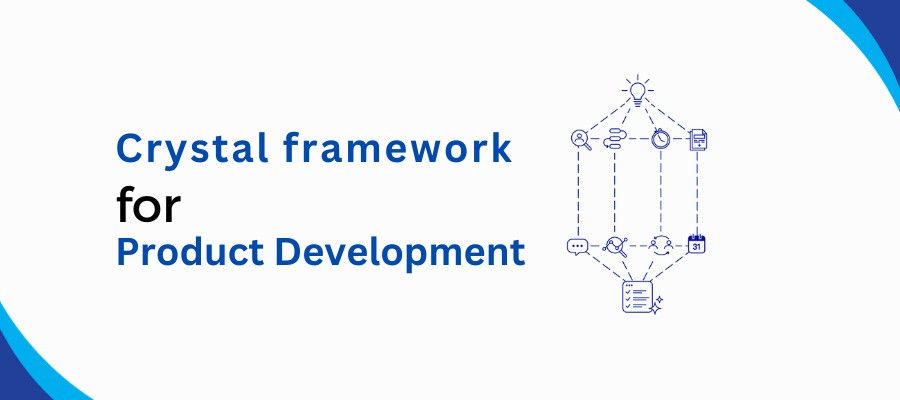Crystal Framework for Product Development

Do you want to explore different Agile methodologies? As an Agile Practitioner, you must know the different Agile approaches, like the Crystal Framework. This flexible and adaptive framework encourages a people-centric culture among enterprises. So, Agile Teams must know the effectiveness of the Crystal Agile framework for Product Development.
Let’s explore the popular methods and principles of the Agile Crystal Framework.
What is the Crystal Method?
The Crystal Agile framework is a set of methodologies designed to help Agile Developers produce software that aligns with the user demands. Alistair Cockburn introduced it in the early 2000s. The Crystal Method emphasizes the people and their interactions over processes and tools. As a result, it is one of the most effective people-centric Agile approaches.
What are the Different Crystal Agile Methods?
The Crystal framework offers multiple methods, including
- Crystal Clear Method: It is ideal for small teams working on critical projects.
- Crystal Yellow Method: It suits projects with slightly more complexity with iterative development.
- Crystal Orange Method: It is a step-up method in terms of complexity and risk management.
- Crystal Red Method: It can handle high-risk projects with complex requirements using advanced techniques.
- Crystal Maroon Method: It can support large-scale projects with substantial complexity and extensive coordination
- Crystal Diamond Method: It is reserved for the most challenging projects where the emphasis is on innovation and experimentation.
So, each Crustal Agile Method is tailored to specific project characteristics. As discussed above, these methods are denoted by colours. The choice of method depends on the project size, criticality, and team experience.
How Does the Crystal Method in Agile Work?
The Crystal Agile framework focuses on creating an environment where teams can self-organize and collaborate. It values individuals and their abilities to develop trust and transparency. Here's how it works:
- Tailored Methods: Crystal encourages teams to select the Crystal method that best suits their project. For instance, Crystal Clear is often chosen for smaller, less complex projects, while Crystal Red is reserved for high-risk endeavours.
- User Stories: Crystal employs User Stories as a way to capture and prioritize user requirements. These stories are concise descriptions of desired functionality to begin the development.
- Collaborative Work: The framework promotes close collaboration between Agile roles. For example, the Scrum Master ensures the team follows Agile principles. The Product Owner manages the Product Backlog. The Agile Developers create the software.
- Adaptive Processes: Crystal acknowledges that one size does not fit all. Teams have the autonomy to adapt processes and practices to suit their specific needs with flexibility.
The Seven Principles of Crystal Agile Framework:
Listing below the seven core principles guide the Crystal Agile Framework:
1. Frequent Delivery: Deliver working software early and often to gather feedback and adapt to changing requirements.
2. Reflective Improvement: Encourage teams to reflect on their processes and make continuous improvements to enhance efficiency and quality.
3. Close Communication: Foster open and transparent communication within the team and with stakeholders to ensure everyone is aligned.
4. Safety: Create a safe environment where team members feel comfortable taking risks and trying new approaches.
5. Focus: Concentrate on the most valuable features and prioritize work based on customer needs and business value.
6. Easy Access to Experts: Ensure easy access to domain experts who can provide insights and guidance throughout the development process.
7. Technical Environment: Invest in a suitable technical environment. Utilize the right Agile tools and resources to support teamwork.
What are the Strengths and Weaknesses of Crystal?
Let’s explore the top advantages and weaknesses the Crystal Method offers to Agile Teams!
Strengths:
- Flexibility: Crystal is highly adaptable. Agile Teams can choose the most appropriate method to achieve the Product Goal.
- People-Centric: It places a strong emphasis on Teamwork and Collaboration. So, individual team members focus on Learning and Coaching to improve.
- Incremental Progress: Frequent delivery of increments enables early feedback and course corrections, reducing the risk of project failure.
- Tailored Solutions: Teams can tailor the Crystal Method to match their specific project requirements.
Weaknesses:
- Complexity: The framework's multitude of methods and principles can be overwhelming for an Agile Beginner like you!
- Lack of Prescriptive Guidance: Some teams may find the lack of detailed processes and practices challenging.
- Not a One-Size-Fits-All: Selecting the wrong Crystal method for a project may lead to suboptimal results.
Conclusion: When to Use Crystal?
The Crystal Agile framework is a valuable addition to the Agile landscape. You can consider the following factors to determine if Crystal is the right fit for your project:
- Project Size and Complexity: Crystal methods suit well with small or medium projects of varying complexity. So, evaluate your project characteristics to choose the appropriate Crystal method.
- Team Experience: Consider the experience level of your Agile practitioners. Crystal may require Agile training and coaching for teams unfamiliar with its principles and methods.
- Organizational Culture: Assess whether your organization's culture aligns with the people-centric and collaborative nature of Crystal. A culture that values teamwork and transparency is more likely to benefit from this framework.
- Desire for Autonomy: If your team values autonomy and the ability to tailor Agile practices to their specific needs, Crystal's flexibility can be a significant advantage.
By carefully evaluating your project's characteristics and team dynamics, you can determine if Crystal is the right choice for your software development endeavors. Remember that Agile Transformation can play a crucial role in successfully implementing the Crystal framework within your organization!
Reference:



